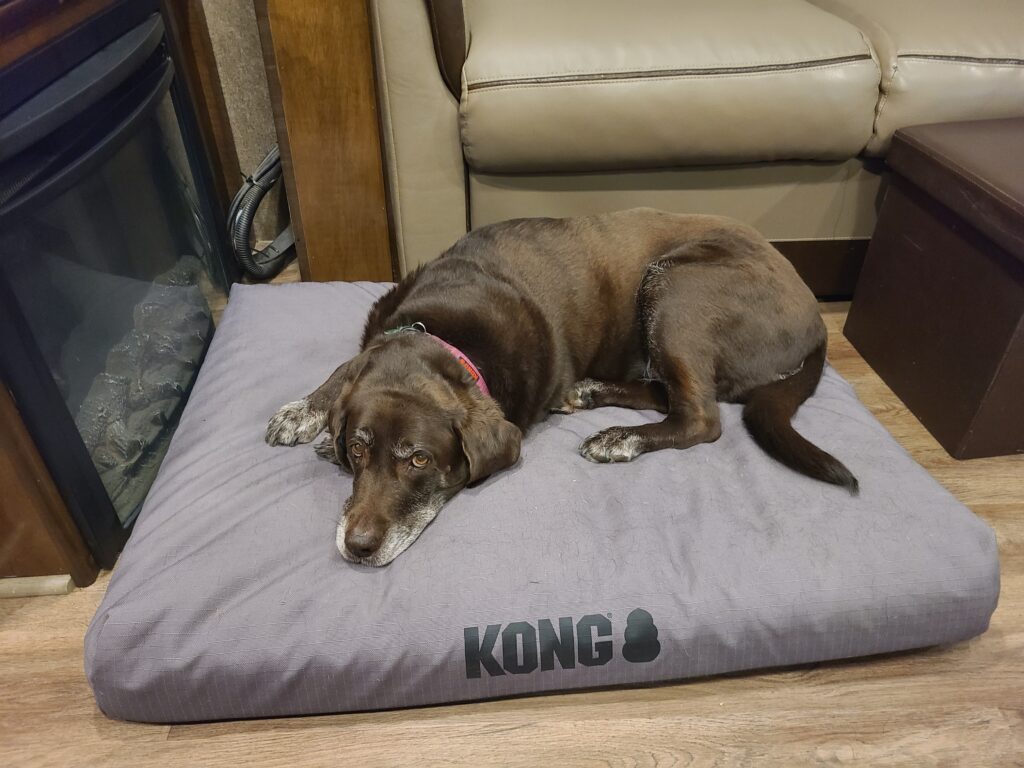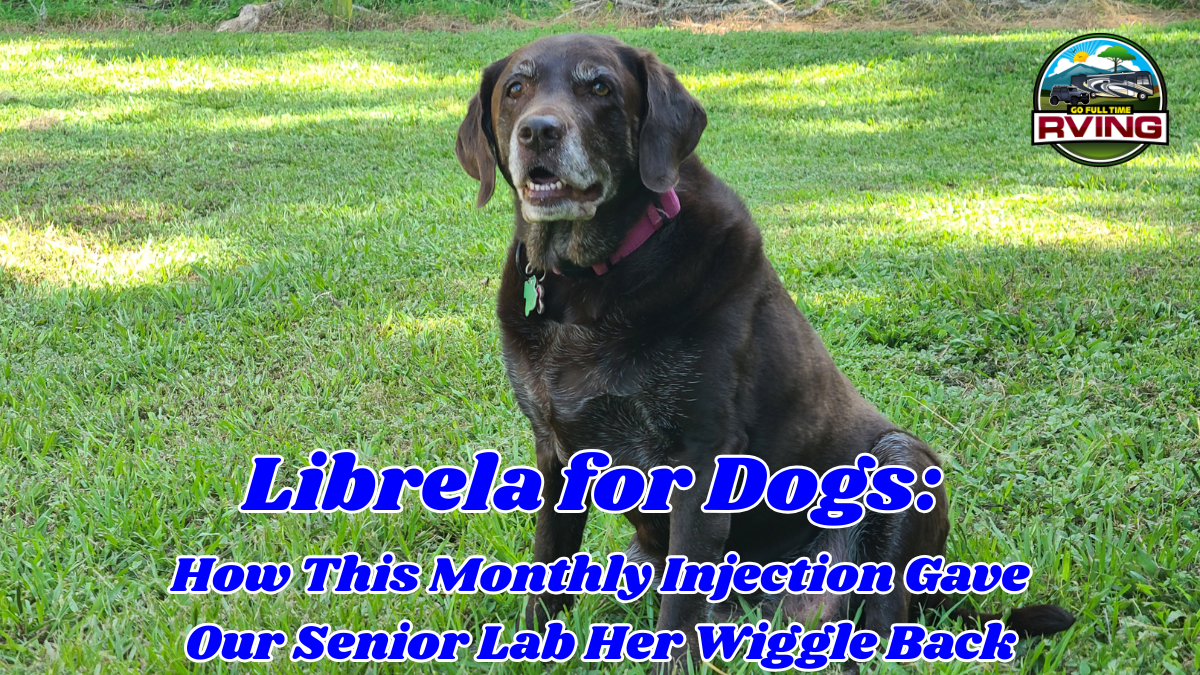If your dog is slowing down, struggling with stairs, or showing signs of joint pain, you’re not alone. Our 10-year-old chocolate lab, Sierra, recently started experiencing hip problems — and like a lot of older Labs, it turned out to be osteoarthritis. After trying NSAIDs and doing our homework, we decided to give Librela a shot. Literally.
Now, just two months in, not only is Sierra moving better — she’s just way happier. If you’re wondering whether Librela is worth it for your dog, here’s our real-life experience as full-time RVers managing a senior pup on the road.
Here’s our honest experience with Librela, and how it’s changed life on the road for our family.
- Early Signs of Dog Arthritis We Couldn’t Ignore
- What is Librela and How Does It Work?
- Doing Our Homework First
- The Results Were Remarkable
- How to Tell Librela is Working: Signs of Improvement in Dogs
- Is Librela Worth It? Pros and Cons of Librela for Dogs with Arthritis
- Tips for RVers Traveling with Senior Dogs
- Frequently Asked Questions About Librela
- Final Thoughts
This post contains affiliate links. As a participant in Amazon Associates and various affiliate programs, we are compensated when qualifying purchases are made through our referral links at no additional cost to you. Full Disclosure
Early Signs of Dog Arthritis We Couldn’t Ignore
A few months back, Sierra tried jumping into our Bronco like she always had — but didn’t quite make it. She yelped, limped away, and we knew something wasn’t right. A trip to the vet confirmed our hunch: likely early-stage osteoarthritis in her hips. Common for her age and breed.
A physical exam pointed to the start of canine osteoarthritis in her hips. It’s common in aging Labradors. The vet gave us NSAIDs, which helped temporarily, and mentioned a new treatment: Librela, a once-a-month injection. We didn’t jump in right away. First, we did our research.
What is Librela and How Does It Work?
Librela is a monoclonal antibody treatment specifically designed for dogs with canine osteoarthritis. Instead of masking pain like traditional meds, it targets nerve growth factor (NGF) — a key player in the pain signaling process — to reduce pain at the source.
- ✅ It’s not an NSAID, so it’s easier on your dog’s liver and kidneys.
- 💉 It’s given once a month via injection at your vet’s office.
- 🐾 Many dog owners report major improvements in comfort, energy, and mobility.
Doing Our Homework First
We’re not the jump-in-headfirst type when it comes to Sierra’s health. We dug into the clinical research, read vet feedback, and joined dog owner groups online. And everywhere we looked, we saw stories that sounded like ours — older dogs slowing down, then perking back up after Librela.
So three weeks after that first vet visit, we took the plunge and had Sierra start Librela.
The Results Were Remarkable
Within a week, we saw our old girl coming back to life.
Sierra started getting up more easily. She climbed into the RV without hesitation. She followed us around camp again. And then one morning, she brought us her ball — tail wagging — like she was inviting us to play.
Now don’t get me wrong — she’s not doing marathon fetch sessions. But she’ll chase that ball three or four times, give us a big doggie grin, and flop down happy. And that happiness? That’s the part that gets us.
Rob’s Tip: Don’t expect a miracle overnight. But if your dog starts wagging more, asking to play, or even just walking easier — you’ll know something’s working.
She just had her second shot a few days ago, and not only is she more mobile — she’s more herself. Playful, curious, content. She’s just way happier.


How to Tell Librela is Working: Signs of Improvement in Dogs
Not every dog reacts the same way, but here’s what we and other owners have noticed:
| Signs Librela Might Be Working |
|---|
| Easier time standing up and lying down |
| Climbing steps or jumping into vehicles again |
| Resuming play (like fetching a ball or tug of war) |
| Better sleep and more relaxed resting positions |
| Increased tail wags and alertness |
| Fewer “bad days” and more steady movement overall |
Is Librela Worth It? Pros and Cons of Librela for Dogs with Arthritis
Here’s our honest breakdown of the benefits and downsides of using Librela based on Sierra’s experience.
| Benefits of Librela for Dogs | Potential Drawbacks of Librela |
|---|---|
| Non-NSAID – safer long-term option for dogs with kidney or liver issues | Not cheap (we pay $84, but some vets charge around $100 per injection) |
| Only one injection per month | Requires a monthly vet visit — tricky for full-time travelers |
| Noticeable improvement in mobility, energy, and mood | Doesn’t work for every dog (effectiveness varies) |
| No side effects observed in our dog | May take several weeks to see full results |
Tips for RVers Traveling with Senior Dogs
Managing arthritis on the road isn’t always easy, but here’s what’s working for us:
- Talk to your vet about Librela — especially if NSAIDs aren’t cutting it
- Use pet stairs or a dog ramp to reduce strain on joints
- Invest in a quality orthopedic dog bed
- Take shorter, more frequent walks instead of long hikes
- Monitor changes in energy, movement, and behavior

We also use a MarCELL temperature monitor and Ring Stick-Up Cams to keep Sierra safe when we’re away from the RV. That peace of mind goes a long way.

Frequently Asked Questions About Librela
💉 How much does Librela cost per month?
We pay $84 per injection, but we’ve spoken with other vets who charge closer to $100. Prices vary by location and clinic.
🐾 How long before Librela starts working?
Some dogs show improvement within a few days, but for others, it may take 2–3 weeks to see noticeable changes. Sierra perked up around day 6 or 7 after her first injection.
⚠️ Are there any side effects?
Sierra hasn’t had any so far. Librela is generally well-tolerated, but as with any medication, there’s always a risk. Mild lethargy or soreness near the injection site is rare but possible.
⏳ How long can my dog stay on Librela?
Librela is designed for long-term use, and studies have shown continued benefit with monthly injections. As always, monitor your dog’s progress and work with your vet.
Final Thoughts
Watching Sierra age hasn’t been easy — but thanks to Librela, she’s got her wiggle back. She’s not chasing deer or leaping off boulders anymore, but she’s fetching her ball, exploring campsites, and greeting every new RV neighbor with that familiar tail thump.
If your dog is struggling with arthritis, Librela might just be the relief they need. It’s been a game-changer for our girl, and we’re so grateful for the extra comfort and quality time it’s giving her.
If you’re looking to build your own home-based business like we have with this webpage, check out Wealthy Affiliate.
Wealthy Affiliate is an all-in-one platform that you can build your whole affiliate marketing business on. It combines training, software, and website hosting into one. This makes the whole process of starting an online business from scratch much easier, especially if you’re new to building a website.



